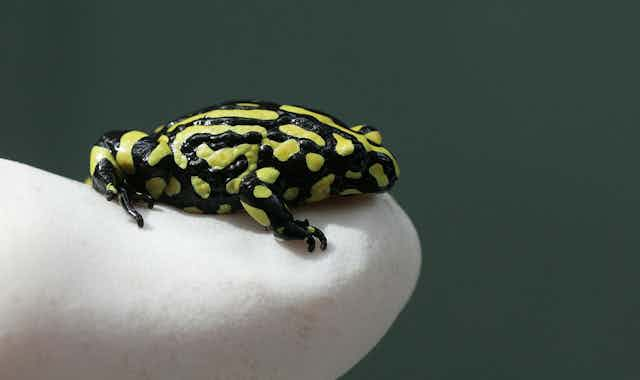While humans worry about bird flu, SARS and other emerging diseases, frogs worldwide are quietly suffering their own pandemic.
The amphibian chytrid fungus was first found in Australia in the 1990s. By then it had already caused at least four frog extinctions including the two gastric-brooding frogs. It is still an ongoing threat to endangered frogs across eastern Australia, like corroboree frogs, torrent frogs and the Beautiful Nursery Frog among many others.
But how did it evolve, and where did it come from?
The frog chytrid has spread across parts of Australia and the Americas since the 1970s, causing widespread mortality, population declines of hundreds of frog species, and extinction of at least 100. Hence the fungus (known as Batrachochytrium dendrobatidis) has caused “the most spectacular loss of vertebrate biodiversity due to disease in recorded history”.
There has been some debate about whether a pathogen acting alone can cause such devastation, but watching uninfected frog populations crash with the arrival of the disease has convinced most of the sceptics. Amphibians have been hugely affected by habitat loss, however the mysterious and sudden disappearance of frogs in protected and remote mountains over the past three decades is due to the frog chytrid.
Chytridiomycosis is the disease the fungus causes. It only infects the skin, and doesn’t appear to cause severe damage to the naked eye. However frog skin performs important functions, such as maintaining the body’s electrolyte, water and oxygen levels. Studies have shown that the fungus disrupts these processes, leading to fatal loss of sodium and potassium.
Working out the origin and evolution of this pathogen has proved difficult. In some regions it has characteristics of an endemic disease. For example in southern Africa and Asia the fungus has been found in museum specimens since at least the start of the 1900s and epidemics have not occurred.
It’s clear that not only do amphibian species vary in their susceptibility but also that different strains of the fungus vary in their virulence. Hence a new genetic study to address these mysteries involved collaboration from researchers worldwide who submitted fungal cultures to Erica Rosenblum at University of California.
Her team used resequencing methods on 49 samples of the fungus. Comparing the DNA of the fungal samples from around the world showed that most fell within a cluster called the “Global Pandemic Lineage”. It is this particular lineage that has spread widely and caused the declines.

The samples contained unexpectedly high diversity, suggesting that this lineage is thousands of years old. The recent emergence of the frog chytrid cannot therefore be explained by the evolution of a new, virulent strain of the fungus. Its emergence is likely due to recent globalisation which has allowed the fungus to spread via trade to new areas with frogs that haven’t experienced the disease before.
There are also other more localised lineages of the fungus, which are likely endemic to specific regions. But these may also have been accidentally moved around, complicating the picture. Further work remains to compare the lineages to work out how they differ in behaviour – particularly in how virulent they are to their hosts and hence what risk they pose to conservation. The study concludes that the results are complex and don’t confirm any one region as the origin of the disease.
Only two Australian samples were included (from Rockhampton and west of Sydney) which were related but distinct. As strains adapt to different habitats over time, it’s not easy to work out in retrospect how many strains have been introduced. Research focusing on the Australian samples is underway, as this is a key question for assessing the effectiveness of Australia’s quarantine and border security.
Other findings from the study explained the high genetic variation of the fungus and found that particular enzymes are important in its evolution, perhaps enabling invasion and digestion of amphibian skin.
Researching chytridiomycosis will help prevent further wildlife pandemics (an emerging threat to biodiversity), and suggests that disease surveillance needs to be expanded. The frog fungus was only identified 18 years after it arrived in Australia and South America, and studying its spread has been done mostly in hindsight.
For frog populations already decimated by this disease, such as the Southern Corroboree Frog in the NSW alps or the Armoured Mistfrog from Queensland’s tropical forests, emergency measures like establishing captive colonies that are disease free are needed, while researchers figure out a solution that will allow the frogs to survive in their infected habitats.

